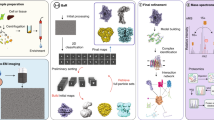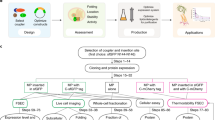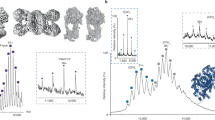Abstract
Membrane proteins are largely underrepresented among available atomic-resolution structures. The use of detergents in protein purification procedures hinders the formation of well-ordered crystals for X-ray crystallography and leads to slower molecular tumbling, impeding the application of solution-state NMR. Solid-state magic-angle spinning NMR spectroscopy is an emerging method for membrane-protein structural biology that can overcome these technical problems. Here we present the solid-state NMR structure of the transmembrane domain of the Yersinia enterocolitica adhesin A (YadA). The sample was derived from crystallization trials that yielded only poorly diffracting microcrystals. We solved the structure using a single, uniformly 13C- and 15N-labeled sample. In addition, solid-state NMR allowed us to acquire information on the flexibility and mobility of parts of the structure, which, in combination with evolutionary conservation information, presents new insights into the autotransport mechanism of YadA.
This is a preview of subscription content, access via your institution
Access options
Subscribe to this journal
Receive 12 print issues and online access
$259.00 per year
only $21.58 per issue
Buy this article
- Purchase on Springer Link
- Instant access to full article PDF
Prices may be subject to local taxes which are calculated during checkout




Similar content being viewed by others
References
Franks, W.T. et al. Magic-angle spinning solid-state NMR spectroscopy of the beta1 immunoglobulin binding domain of protein G (GB1): 15N and 13C chemical shift assignments and conformational analysis. J. Am. Chem. Soc. 127, 12291–12305 (2005).
Jehle, S. et al. Solid-state NMR and SAXS studies provide a structural basis for the activation of alphaB-crystallin oligomers. Nat. Struct. Mol. Biol. 17, 1037–1042 (2010).
Wasmer, C. et al. Amyloid fibrils of the HET-s(218–289) prion form a beta solenoid with a triangular hydrophobic core. Science 319, 1523–1526 (2008).
Hong, M., Zhang, Y. & Hu, F. Membrane protein structure and dynamics from NMR spectroscopy. Annu. Rev. Phys. Chem. 63, 1–24 (2012).
McDermott, A. Structure and dynamics of membrane proteins by magic angle spinning solid-state NMR. Annu. Rev. Biophys. 38, 385–403 (2009).
Judge, P.J. & Watts, A. Recent contributions from solid-state NMR to the understanding of membrane protein structure and function. Curr. Opin. Chem. Biol. 15, 690–695 (2011).
Ketchem, R.R., Hu, W. & Cross, T.A. High-resolution conformation of gramicidin A in a lipid bilayer by solid-state NMR. Science 261, 1457–1460 (1993).
Das, B.B. et al. Structure determination of a membrane protein in proteoliposomes. J. Am. Chem. Soc. 134, 2047–2056 (2012).
Linke, D., Riess, T., Autenrieth, I.B., Lupas, A. & Kempf, V.A. Trimeric autotransporter adhesins: variable structure, common function. Trends Microbiol. 14, 264–270 (2006).
Nummelin, H. et al. The Yersinia adhesin YadA collagen-binding domain structure is a novel left-handed parallel beta-roll. EMBO J. 23, 701–711 (2004).
Grosskinsky, U. et al. A conserved glycine residue of trimeric autotransporter domains plays a key role in Yersinia adhesin A autotransport. J. Bacteriol. 189, 9011–9019 (2007).
Lehr, U. et al. C-terminal amino acid residues of the trimeric autotransporter adhesin YadA of Yersinia enterocolitica are decisive for its recognition and assembly by BamA. Mol. Microbiol. 78, 932–946 (2010).
Roggenkamp, A. et al. Molecular analysis of transport and oligomerization of the Yersinia enterocolitica adhesin YadA. J. Bacteriol. 185, 3735–3744 (2003).
Wollmann, P., Zeth, K., Lupas, A.N. & Linke, D. Purification of the YadA membrane anchor for secondary structure analysis and crystallization. Int. J. Biol. Macromol. 39, 3–9 (2006).
Shahid, S.A., Markovic, S., Linke, D. & van Rossum, B.-J. Assignment and secondary structure of the YadA membrane protein by solid-state MAS NMR. Sci. Rep. doi: 10.1038/srep00803 (in the press).
Rieping, W., Habeck, M. & Nilges, M. Inferential structure determination. Science 309, 303–306 (2005).
Bayrhuber, M. et al. Structure of the human voltage-dependent anion channel. Proc. Natl. Acad. Sci. USA 105, 15370–15375 (2008).
Kuszewski, J. et al. Completely automated, highly error-tolerant macromolecular structure determination from multidimensional nuclear Overhauser enhancement spectra and chemical shift assignments. J. Am. Chem. Soc. 126, 6258–6273 (2004).
Meng, G., Surana, N.K., St Geme, J.W. III. & Waksman, G. Structure of the outer membrane translocator domain of the Haemophilus influenzae Hia trimeric autotransporter. EMBO J. 25, 2297–2304 (2006).
Alvarez, B.H. et al. A transition from strong right-handed to canonical left-handed supercoiling in a conserved coiled-coil segment of trimeric autotransporter adhesins. J. Struct. Biol. 170, 236–245 (2010).
Ieva, R., Skillman, K.M. & Bernstein, H.D. Incorporation of a polypeptide segment into the beta-domain pore during the assembly of a bacterial autotransporter. Mol. Microbiol. 67, 188–201 (2008).
Leo, J.C., Grin, I. & Linke, D. Type V secretion: mechanism(s) of autotransport through the bacterial outer membrane. Phil. Trans. R. Soc. Lond. B 367, 1088–1101 (2012).
Phan, G. et al. Crystal structure of the FimD usher bound to its cognate FimC-FimH substrate. Nature 474, 49–53 (2011).
Junker, M., Besingi, R.N. & Clark, P.L. Vectorial transport and folding of an autotransporter virulence protein during outer membrane secretion. Mol. Microbiol. 71, 1323–1332 (2009).
Peterson, J.H., Tian, P., Ieva, R., Dautin, N. & Bernstein, H.D. Secretion of a bacterial virulence factor is driven by the folding of a C-terminal segment. Proc. Natl. Acad. Sci. USA 107, 17739–17744 (2010).
Lupas, A.N. & Gruber, M. The structure of alpha-helical coiled coils. Adv. Protein Chem. 70, 37–78 (2005).
Leo, J.C. et al. The structure of E. coli IgG-binding protein D suggests a general model for bending and binding in trimeric autotransporter adhesins. Structure 19, 1021–1030 (2011).
Tang, M. et al. High-resolution membrane protein structure by joint calculations with solid-state NMR and X-ray experimental data. J. Biomol. NMR 51, 227–233 (2011).
Arnold, T. & Linke, D. Phase separation in the isolation and purification of membrane proteins. Biotechniques 43, 427–440 (2007).
Schaefer, J. & Stejskal, E.O. Carbon-13 nuclear magnetic resonance of polymers spinning at the magic angle. J. Am. Chem. Soc. 98, 1031–1032 (1976).
Sinha, N. et al. SPINAL modulated decoupling in high field double- and triple-resonance solid-state NMR experiments on stationary samples. J. Magn. Reson. 177, 197–202 (2005).
Morcombe, C.R., Gaponenko, V., Byrd, R.A. & Zilm, K.W. Diluting abundant spins by isotope edited radio frequency field assisted diffusion. J. Am. Chem. Soc. 126, 7196–7197 (2004).
Takegoshi, K., Yano, T., Takeda, K. & Terao, T. Indirect high-resolution observation of 14N NMR in rotating solids. J. Am. Chem. Soc. 123, 10786–10787 (2001).
Szeverenyi, N.M., Sullivan, M.J. & Maciel, G.E. Observation of spin exchange by two-dimensional Fourier transform 13C cross polarization-magic-angle spinning. J. Magn. Reson. 47, 462–475 (1982).
Lange, A. et al. A concept for rapid protein-structure determination by solid-state NMR spectroscopy. Angew. Chem. Int. Edn Engl. 44, 2089–2092 (2005).
De Paëpe, G., Lewandowski, J.R., Loquet, A., Böckmann, A. & Griffin, R.G. Proton assisted recoupling and protein structure determination. J. Chem. Phys. 129, 245101 (2008).
Hing, A.W., Vega, S. & Schaefer, J. Transferred-echo double-resonance NMR. J. Magn. Reson. 96, 205–209 (1992).
Jaroniec, C.P., Filip, C. & Griffin, R.G. 3D TEDOR NMR experiments for the simultaneous measurement of multiple carbon-nitrogen distances in uniformly 13C,15N-labeled solids. J. Am. Chem. Soc. 124, 10728–10742 (2002).
Gullion, T. & Schaefer, J. Rotational-echo double-resonance NMR. J. Magn. Reson. 81, 196–200 (1989).
Wu, X.L., Burns, S.T. & Zilm, K.W. Spectral editing in CPMAS NMR. Generating subspectra based on proton multiplicities. J. Magn. Reson. A 111, 29–36 (1994).
Opella, S.J., Frey, M.H. & Cross, T.A. Detection of individual carbon resonances in solid proteins. J. Am. Chem. Soc. 101, 5856–5857 (1979).
Opella, S.J. & Frey, M.H. Selection of nonprotonated carbon resonances in solid-state nuclear magnetic resonance. J. Am. Chem. Soc. 101, 5854–5856 (1979).
Shen, Y., Delaglio, F., Cornilescu, G. & Bax, A. TALOS+: a hybrid method for predicting protein backbone torsion angles from NMR chemical shifts. J. Biomol. NMR 44, 213–223 (2009).
Berjanskii, M.V. & Wishart, D.S. A simple method to predict protein flexibility using secondary chemical shifts. J. Am. Chem. Soc. 127, 14970–14971 (2005).
Marsh, J.A., Singh, V.K., Jia, Z. & Forman-Kay, J.D. Sensitivity of secondary structure propensities to sequence differences between alpha- and gamma-synuclein: implications for fibrillation. Protein Sci. 15, 2795–2804 (2006).
Shen, Y. & Bax, A. Protein backbone chemical shifts predicted from searching a database for torsion angle and sequence homology. J. Biomol. NMR 38, 289–302 (2007).
Bardiaux, B., van Rossum, B.J., Nilges, M. & Oschkinat, H. Efficient modeling of symmetric protein aggregates from NMR data. Angew. Chem. Int. Edn Engl. 51, 6916–6919 (2012).
Szczesny, P. & Lupas, A. Domain annotation of trimeric autotransporter adhesins–daTAA. Bioinformatics 24, 1251–1256 (2008).
Altschul, S.F. et al. Gapped BLAST and PSI-BLAST: a new generation of protein database search programs. Nucleic Acids Res. 25, 3389–3402 (1997).
Biegert, A., Mayer, C., Remmert, M., Söding, J. & Lupas, A.N. The MPI Bioinformatics Toolkit for protein sequence analysis. Nucleic Acids Res. 34, W335–W339 (2006).
Edgar, R.C. MUSCLE: multiple sequence alignment with high accuracy and high throughput. Nucleic Acids Res. 32, 1792–1797 (2004).
Acknowledgements
This work was supported by contract research 'Forschungsprogramm Methoden für die Lebenswissenschaften' of the Baden-Württemberg Stiftung to M.H. and D.L.; additional funding was from the European Union Seventh Framework Programme (FP7/2007-2013) under grant agreement no. 261863 (Bio-NMR) to B.B. and W.T.F., the Deutsche Forschungsgemeinschaft (HA 5918/1-1 to M.H., SFB 766 to D.L. and SFB 740 to B.-J.v.R. and W.T.F.), and institutional funds of the Leibniz Society and the Max Planck Society. The authors thank H. Oschkinat and A. Lupas for continuing support and H. Schwarz for his electron microscopy work.
Author information
Authors and Affiliations
Contributions
L.K. and D.L. conceived of the project; B.-J.v.R. and D.L. designed the experiments; S.A.S., B.-J.v.R., W.T.F, L.K. and D.L. performed the experiments; S.A.S., M.H. and B.B. performed the structure calculations; and S.A.S., B.-J.v.R., M.H, B.B. and D.L. interpreted the data and wrote the paper.
Corresponding authors
Ethics declarations
Competing interests
The authors declare no competing financial interests.
Supplementary information
Supplementary Text and Figures
Supplementary Figures 1 and 2, Supplementary Table 1 and Supplementary Notes 1–5 (PDF 4653 kb)
Rights and permissions
About this article
Cite this article
Shahid, S., Bardiaux, B., Franks, W. et al. Membrane-protein structure determination by solid-state NMR spectroscopy of microcrystals. Nat Methods 9, 1212–1217 (2012). https://doi.org/10.1038/nmeth.2248
Received:
Accepted:
Published:
Issue Date:
DOI: https://doi.org/10.1038/nmeth.2248
This article is cited by
-
Growing and making nano- and microcrystals
Nature Protocols (2023)
-
NMR spectroscopy of lipidic cubic phases
Biophysical Reviews (2022)
-
Comparative analysis of 13C chemical shifts of β-sheet amyloid proteins and outer membrane proteins
Journal of Biomolecular NMR (2021)
-
MAS NMR detection of hydrogen bonds for protein secondary structure characterization
Journal of Biomolecular NMR (2020)
-
Recent advances in the understanding of trimeric autotransporter adhesins
Medical Microbiology and Immunology (2020)



